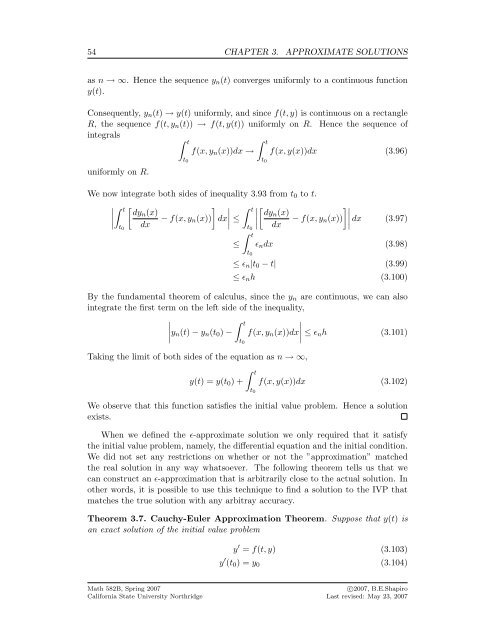The Computable Differential Equation Lecture ... - Bruce E. Shapiro
The Computable Differential Equation Lecture ... - Bruce E. Shapiro
The Computable Differential Equation Lecture ... - Bruce E. Shapiro
You also want an ePaper? Increase the reach of your titles
YUMPU automatically turns print PDFs into web optimized ePapers that Google loves.
54 CHAPTER 3. APPROXIMATE SOLUTIONS<br />
as n → ∞. Hence the sequence y n (t) converges uniformly to a continuous function<br />
y(t).<br />
Consequently, y n (t) → y(t) uniformly, and since f(t, y) is continuous on a rectangle<br />
R, the sequence f(t, y n (t)) → f(t, y(t)) uniformly on R. Hence the sequence of<br />
integrals<br />
uniformly on R.<br />
∫ t<br />
t 0<br />
f(x, y n (x))dx →<br />
∫ t<br />
t 0<br />
f(x, y(x))dx (3.96)<br />
We now integrate both sides of inequality 3.93 from t 0 to t.<br />
∫ t<br />
[ ]<br />
∫ dyn (x)<br />
t<br />
∣[ ∣∣∣<br />
∣<br />
− f(x, y n (x)) dx<br />
t 0<br />
dx<br />
∣ ≤ dyn (x)<br />
∣∣∣<br />
− f(x, y n (x))]∣<br />
dx (3.97)<br />
t 0<br />
dx<br />
∫ t<br />
≤ ɛ n dx (3.98)<br />
t 0<br />
≤ ɛ n |t 0 − t| (3.99)<br />
≤ ɛ n h (3.100)<br />
By the fundamental theorem of calculus, since the y n are continuous, we can also<br />
integrate the first term on the left side of the inequality,<br />
∫ t<br />
∣ y n(t) − y n (t 0 ) − f(x, y n (x))dx<br />
∣ ≤ ɛ nh (3.101)<br />
t 0<br />
Taking the limit of both sides of the equation as n → ∞,<br />
∫ t<br />
y(t) = y(t 0 ) + f(x, y(x))dx (3.102)<br />
t 0<br />
We observe that this function satisfies the initial value problem. Hence a solution<br />
exists.<br />
When we defined the ɛ-approximate solution we only required that it satisfy<br />
the initial value problem, namely, the differential equation and the initial condition.<br />
We did not set any restrictions on whether or not the ”approximation” matched<br />
the real solution in any way whatsoever. <strong>The</strong> following theorem tells us that we<br />
can construct an ɛ-approximation that is arbitrarily close to the actual solution. In<br />
other words, it is possible to use this technique to find a solution to the IVP that<br />
matches the true solution with any arbitray accuracy.<br />
<strong>The</strong>orem 3.7. Cauchy-Euler Approximation <strong>The</strong>orem. Suppose that y(t) is<br />
an exact solution of the initial value problem<br />
y ′ = f(t, y) (3.103)<br />
y ′ (t 0 ) = y 0 (3.104)<br />
Math 582B, Spring 2007<br />
California State University Northridge<br />
c○2007, B.E.<strong>Shapiro</strong><br />
Last revised: May 23, 2007
















